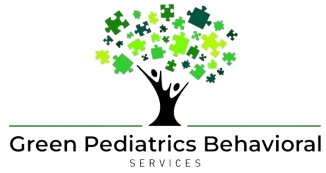A Parent’s Guide: What to Expect at Your Child’s First ABA Therapy Session
Starting Applied Behavior Analysis (ABA) therapy is a significant step for families with a child on the Autism Spectrum Disorder (ASD). At GreenPediatrics Behavioral, we understand you might have many questions, especially about what that very first ABA therapy session will look like. As a provider owned and operated by Board Certified Behavior Analysts (BCBAs), we’re here to demystify the process and set your mind at ease.
Our goal for the initial interactions is always to build rapport, understand your child’s unique strengths and needs, and create a positive foundation for future learning.

Before the “First Session”: The Initial Consultation & Assessment
Technically, before direct therapy begins, there’s usually an initial consultation or intake process. This might involve:
- Parent Interview: We’ll talk with you to understand your concerns, goals for your child, your child’s developmental history, strengths, and areas where they need support.
- Review of Records: Any diagnostic reports or previous therapy notes are helpful.
- Initial Assessment: A BCBA may conduct an initial assessment. This isn’t about “testing” your child in a formal sense, but more about observing them, perhaps through play, and using standardized assessment tools to identify skill deficits and excesses. This helps us develop a tailored treatment plan.
This preliminary stage is crucial for us to get to know your family and for you to get to know GreenPediatrics Behavioral.
The First
Once the initial assessments are complete and a treatment plan is emerging, the first direct therapy session with your child will take place. Here’s what you can generally expect:
Short Duration: The very first few sessions might be shorter, gradually increasing as your child becomes more comfortable.
Focus on Pairing & Rapport Building: This is paramount. The therapist (often a Registered Behavior Technician, or RBT, supervised by a BCBA) will spend this time “pairing” with your child. This means associating themselves with fun, reinforcement, and positive experiences. Think of it as building a trusting friendship.
What it looks like: Engaging in your child’s preferred activities, playing games they enjoy, offering choices, and keeping demands low. The goal is for your child to want to be with the therapist.
Play-Based Interactions: Especially for younger children, the session will likely look a lot like structured play. ABA techniques can be seamlessly integrated into natural play activities. This is often referred to as Natural Environment Teaching (NET).
Observation and Informal Assessment Continues: While playing, the therapist is still observing your child’s communication, social interaction, play skills, and responses to simple requests.
Introduction to Basic Concepts (if appropriate): Depending on your child’s level, the therapist might gently introduce very simple learning opportunities, always paired with high levels of reinforcement.
What Your Child Will (and Won’t) Be Doing
Will Do: Engage in preferred activities, explore new toys with the therapist, receive lots of praise and positive attention.
Won’t Do (Typically): Be forced into activities, sit at a table for long drills (especially initially), or experience a high-pressure environment. Our BCBA-led approach emphasizes a child-centered, positive start.
The Parent’s Role During the First Session
Your involvement is key! During the first session, you might:
Participate (if invited): The therapist might model strategies for you or ask you to join in an activity.
Be Present: Especially for younger children or those with separation anxiety, your presence can be comforting.
Observe: See how the therapist interacts with your child. This is a great learning opportunity.
Provide Information: The therapist may have questions for you about your child’s preferences or communication style.
After the Session: Debrief and Next Steps
- The BCBA supervising your child’s case will discuss how the session went, share observations, and outline the next steps. This is a good time to ask any questions you have. The focus will be on:
- Solidifying the treatment plan.
- Setting initial goals.
- Scheduling future sessions.
- Discussing parent training components.
Read More: 8 reasons why Green Pediatrics Behavioral Services will be the perfect match for your child’s needs.
Tips for a Smooth First ABA Session for Your Child with ASD
Talk to Your Child (if appropriate): In simple terms, explain they’ll be meeting a new friend to play with.
Keep Your Routine: As much as possible, stick to your child’s normal routine on the day of the session.
Communicate with Us: Share any anxieties your child (or you!) might have. We’re here to support you.
Stay Positive: Your child can pick up on your emotions. A calm, positive attitude can make a big difference.
GreenPediatrics Behavioral: Your BCBA-Owned Partner in Progress
At GreenPediatrics Behavioral, being owned and operated by BCBAs means that every aspect of your child’s ABA therapy, from the very first ABA therapy session onwards, is guided by expert clinical knowledge and a deep commitment to ethical, effective, and compassionate care for individuals with Autism Spectrum Disorder. We believe in building strong therapeutic relationships to help your child reach their full potential.Ready to take the next step? Contact GreenPediatrics Behavioral today for a consultation. We’re eager to answer your questions and discuss how our ABA therapy services can support your child and family.
